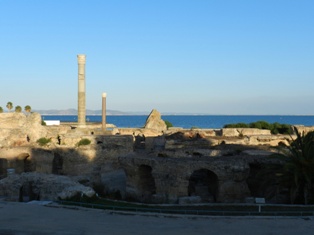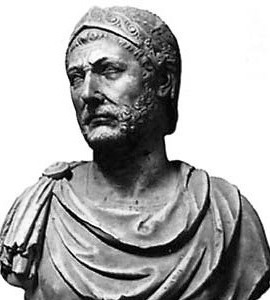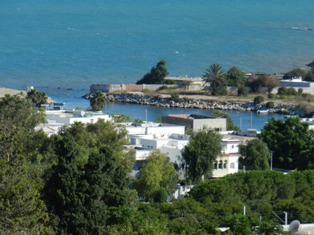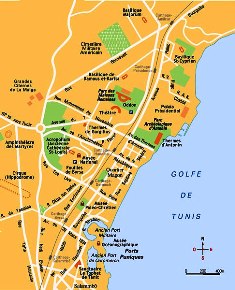Carthage was founded by the Phoenicians from Tire in 814 BC. It became a rival of Rome for the domination of the Western Mediterranean in the fourth century BC. This rivalry turned into an armed conflict originating in the struggle for influence in Sicily, which was controlled by both powers. This confrontation took place in three phases commonly called Punic Wars. These three wars began in the third century BC to end in 146 BC with the victory of Rome and the destruction of Carthage.
According to legend, it was Queen Elyssa Didon, sister of the king of Tyr Pygmalion, who founded the city, with the help of some settlers and warriors, in the middle of the 8th century (in 814 BC).
|

The baths of Antonin |
The Byrsa Museum has wonderful archaeological pieces from the Punic era
Exceptional place of brewing, dissemination and outbreak of
several successive cultures (phenico-punic, roman,
Paleochristian and Arab), this metropolis and its ports have favored
large-scale exchanges in the Mediterranean. Founded at the end
from the 9th century BC J-C by Elyssa-Didon and having hosted the loves
myths of Dido and Aeneas, Carthage engendered a warlord and engineering strategist like Hannibal, a browser-explorer like
Hannon, and an agronomist of great renown like Magon. By its
historical and literary resonance, Carthage has always nourished
the universal imaginary.
and engineering strategist like Hannibal, a browser-explorer like
Hannon, and an agronomist of great renown like Magon. By its
historical and literary resonance, Carthage has always nourished
the universal imaginary.
The property includes the remains of the Punic, Roman,
vandal, paleochristian and Arabic. The main components
The Carthage site is the acropolis of Byrsa, the ports
Punic, Punic tophet, necropolis, theater,
the amphitheater, the circus, the villa district, the basilicas,
the baths of Antonin, the cisterns of Malaga and the reserve
archaeological.
|
The First Punic War (264-241 BC)
(264-241 av.J-C). This war took place largely at sea. Each of the two powers wanted to annex Sicily. The final battle was won by Rome.
The Second Punic War (218-202 BC).
Revitalized by his victory of Sagunto in Hispania Hannibal took advantage of it to establish a base that allowed him to organize his troops. His valiant warriors and elephants served him later to cross the Pyrenees and the Alps and did not stop until the gates of Rome. Private reinforcement Hannibal eventually lost the game.
The Third Punic War (149-146 BC). Affected by the Numidian uprisings was not able to support the Rome offensive in Africa. Obsessed by this rival African city and fearing a new Punic offensive, the Romans had no choice but to destroy and burn Carthage.

What's left of the Punic port
The end of Carthage.
Led by Scipio the African, the siege of Carthage lasted three years and ended with a tragic end: the city was completely destroyed, its remains razed (then backfilled) and the soil was sown with salt so that nothing could repel. This ritual is a perfect illustration of Rome's fear of Carthage. Despite this defeat, the Carthaginian civilization will not disappear, since it will be renamed later, in a brand new civilization: that of Roman Africa.
|
